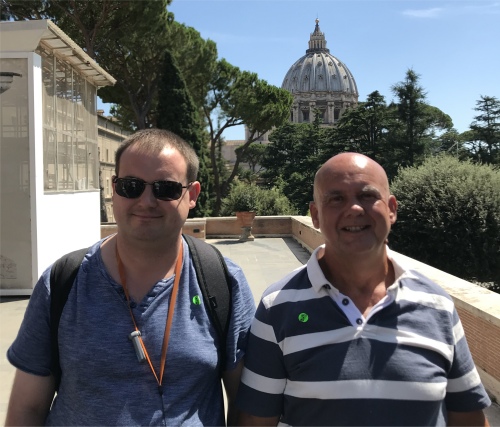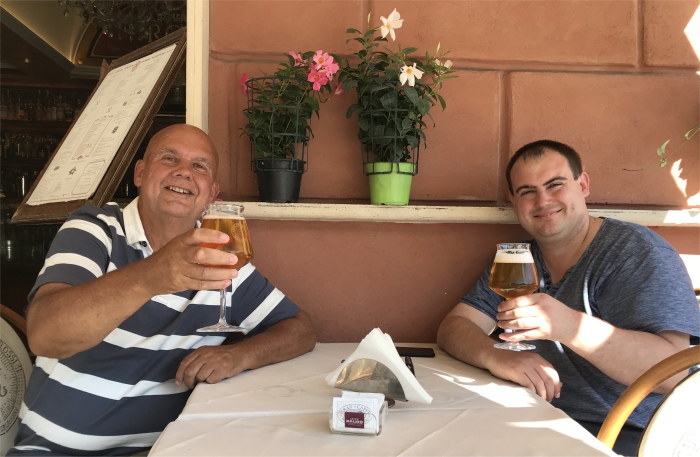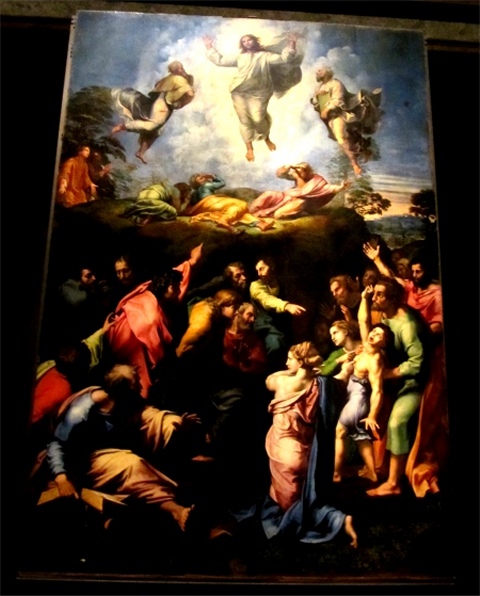
Raphael's "Transfiguration" (1516-1520) in the Pinacoteca
|
The independent State, defined by the Lateran Treaty of 11 February 1929, extends its territorial sovereignty over an area of 44 ha in the centre of Rome: Vatican City enclosed by its walls and open toward the city through Bernini's colonnade of Saint Peter's. The boundaries of the city-state contain masterpieces and living institutions that are a witness to the unique continuity of the crucial role played by this place in the history of mankind. The Centre of Christianity since the foundation of Saint Peter's Basilica by Constantine (4th century), and at a later stage the permanent seat of the Popes, the Vatican is at once the pre-eminently holy city for Catholics, an important archaeological site of the Roman world and one of the major cultural reference points of both Christians and non-Christians.

Caravaggio's "Deposition from the Cross" (1600-1604)
|
Its prestigious history explains the development of an architectural and artistic ensemble of exceptional value. Beneath the basilica of Saint Peter, reconstructed in the 16th century under the guidance of the most brilliant architects of the Renaissance, remains of the first basilica founded by Constantine still exist, as well as ruins of the circus of Caligula and Nero, and a Roman necropolis of the 1st century AD, where Saint Peter's tomb is located. Under Julius II's patronage in 1506, an extraordinary artistic era was inaugurated, leading to the decoration of Raphael's Stanze and of the Sistine Chapel with frescoes by Michelangelo, along with the building of the new basilica, completed in 1626, fruit of the combined genius of Bramante, Raphael, Michelangelo, Bernini, Maderno and Della Porta.
The Vatican Palace is the result of a long series of additions and modifications by which, from the Middle Ages, the Popes rivalled each other in magnificence. The original building of Nicholas III (1277-1280) was enlarged in the 15th, 16th and 17th centuries: the history of the arts of the Renaissance and Baroque periods iconic models are found here.
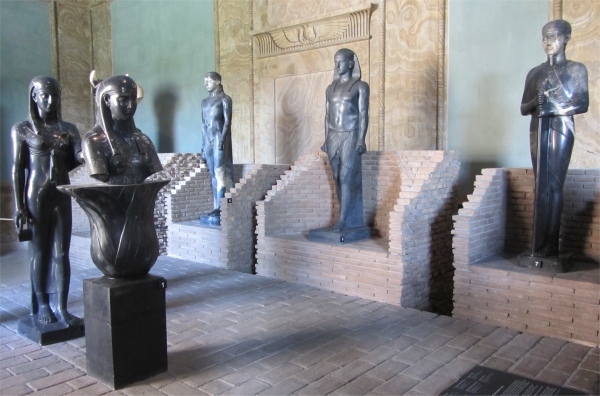
Reconstruction of the Serapeum of the Canopus of Hadrian's Villa, Tivoli in the Gregorian Egyptian Museum
|
In 1475, Sixtus IV founded the Vatican Library, which is the first open to the public in Europe; the collections of manuscripts and books, prints, drawings, coins and decorative arts, constantly increased through the centuries, making it an invaluable repository of human culture.
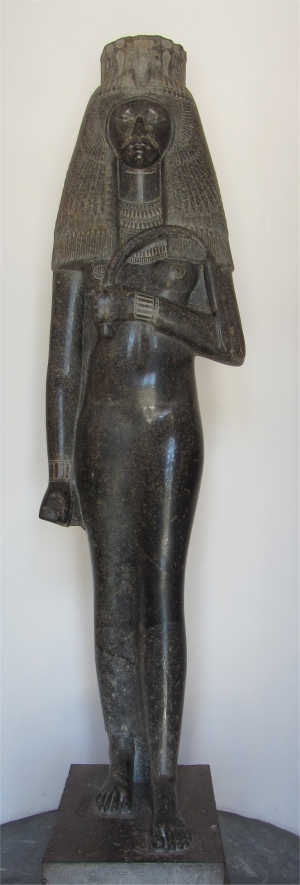
Tuya
|
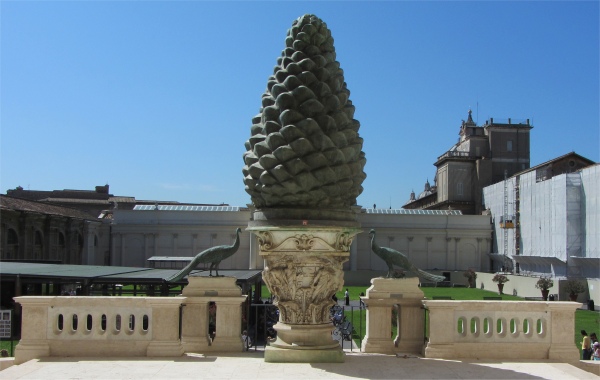
Terrace of the "Niche of the Pinecone" Overlooking the Courtyard of the Pinecone
|
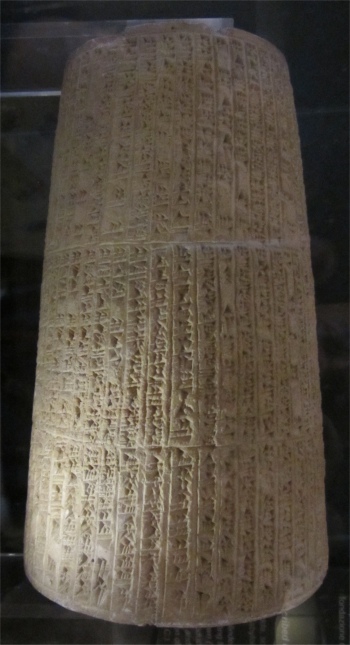
Inscribed Cylinder of Nabuchadnezar II
|
From the mid-18th century, the popes' efforts were also directed towards expanding the private collections of antiquities dating back to the Renaissance: their transformation into public museums accessible to scholars and connoisseurs marks the origin of the Vatican Museums. New buildings were built specifically to house the classical sculptures, such as the Pio-Clementine Museum, which represents a milestone in the history of European culture. The 19th- and 20th-century additions of new and diverse collections and buildings accord with the tradition of papal patronage.
Hmmm .... certainly a place worth visiting then. We wound our way up a spiral staircase, collected an audio guide each, and stepped out on the sun-soaked Cortile della Pinacoteca terrace. St. Peter's Dome served as a backdrop to this vantage point, and below lay the Giardino Quadrato gardens.
The gardens below were too tempting, so we headed down a staircase and stepped out into a sunny oasis. Around the gardens stood several large displays, all identical, and each showing photographs of the artwork inside the Sistine Chapel. On the northern side of the gardens, the long Pinacoteca dei Musei Vaticani stretched.
I can never resist an art gallery, and plunged in. The new Vatican Pinacoteca (Art Gallery) was inaugurated on 27 October 1932 in the building especially constructed by the architect Luca Beltrami for Pius XI. It was built in the nineteenth century Square Garden, isolated and completely surrounded by avenues, in a place considered suitable for assuring the best lighting conditions for both the correct preservation of the works and their optimum aesthetic enhancement. Thus the age-old question of the exhibition of the paintings, which were constantly moved around the Apostolic Palaces due to the lack of a setting that matched their importance, was solved. A first collection of only 118 precious paintings was created by Pope Pius VI around 1790. It was of short duration due to the fact that, following the Treaty of Tolentino (1797) some of the greatest masterpieces were transferred to Paris. The idea of an art gallery, understood in the modern sense as an exhibition open to the public, was only born in 1817 after the fall of Napoleon and the consequent return to the Church State of a large part of the works belonging to it, according to the directions of the Congress of Vienna. The collection continued to grow over the years through donations and purchases until it reached the current nucleus of 460 paintings, distributed among the eighteen rooms on the basis of chronology and school, from the so-called Primitives (12th - 13th century) to the 19th century. The collection contains some masterpieces of the greatest artists of the history of Italian painting, from Giotto to Fra Angelico, from Melozzo da Forlė to Perugino and to Raphael, from Leonardo to Tiziano, to Veronese, to Caravaggio and to Crespi.

Pio Clementino Museum
|
Among the Vatican Pinacoteca most interesting rooms is Room VIII, the Raphael Room. This room houses five works by Raphael and a number of tapestries. Perhaps the most famous of the bunch is "Transfiguration", considered Raphael's final work which was finished upon his early death by one of his pupils. The split canvas expresses in dark and light, the connection between God and his people. The next room, Room IX contains a work by Leonardo da Vinci - a warm-up for the Sistine Chapel perhaps - called St. Jerome. The unfinished work, still in sketch form, is a fantastic insight into how the painter worked. A man you don't see much of in the Vatican Museums or Rome's churches appears in Room XII. Caravaggio's "Deposition from the Cross" shows the master's skill with light. The "Deposition from the Cross", considered one of Caravaggio's greatest masterpieces, was commissioned by Girolamo Vittrice for his family chapel in S. Maria in Vallicella (Chiesa Nuova) in Rome. In 1797 it was included in the group of works transferred to Paris in execution of the Treaty of Tolentino. After its return in 1817 it became part of Pius VII's Pinacoteca.
Once we'd had our fill of the Pinacoteca's impressive collection, we headed across the Atrio del Quattro Cancelli (Atrium of the Four Gates) to the Gregoriano Egiziano Museum (Gregorian Egyptian Museum), inaugurated on 2nd February 1839 to commemorate the anniversary of Gregory XVI's accession to the papacy. The creation of the Gregoriano Egiziano Museum was particularly close to the pope's heart as he believed the understanding of ancient Egyptian civilisation was vital in terms of its scientific importance as well as its value in understanding the Old Testament. This feeling was expressed in a paper by the museum's first curator, the physiologist and Barnabite, Father Luigi Maria Ungarelli, an eminent Egyptologist of the age and disciple of Ippolito Rosellini.
Various architectural elements and wall decorations of exotic inspiration remain of this first layout, intended to evoke the environs of the Nile. The collection is particularly interesting on account of its relationship with the territory, rich in material from Roman Egypt and from Egyptian-influenced Rome. Indeed, many monuments from the most ancient nucleus were brought to Rome at the behest of the emperor in order to embellish buildings, shrines and villas, such as the statuary group of the Gardens of Sallust (Horti Sallustiani), now displayed in the Hemicycle that opens onto the terrace of the "Niche of the Pinecone". The terrace affords a commanding view over the Cortile della Pigna (Courtyard of the Pinecone). There are also many Egyptian works of Roman production, which offer evidence of an important moment in the history of pharaonic culture, as in the case of the items from the splendid setting of Hadrian's Villa in Tivoli.
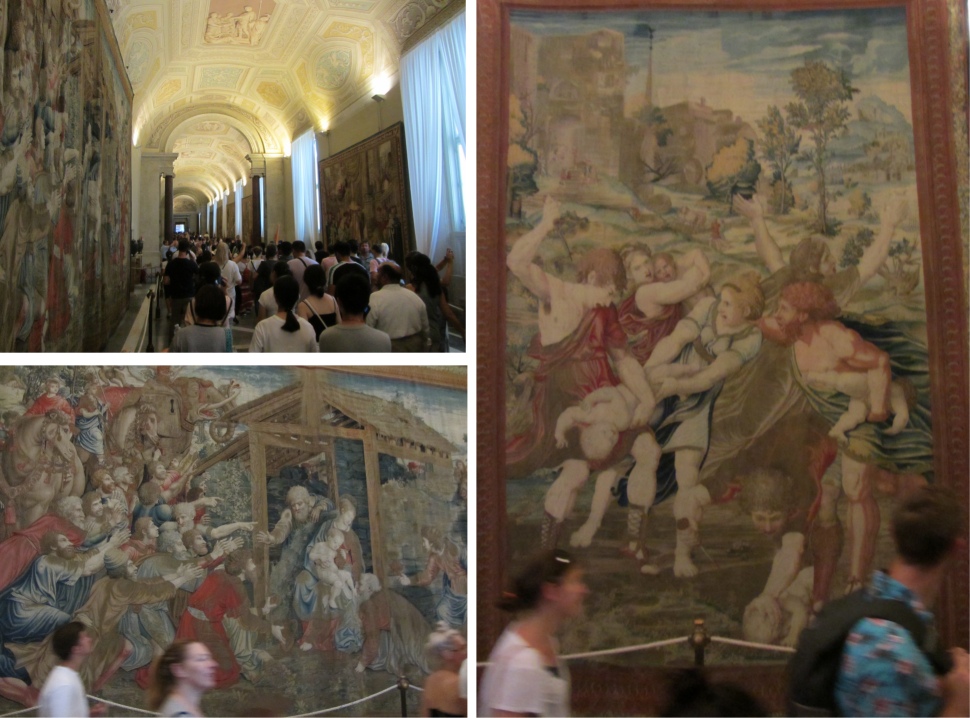
Galleria degli Arazzi
|
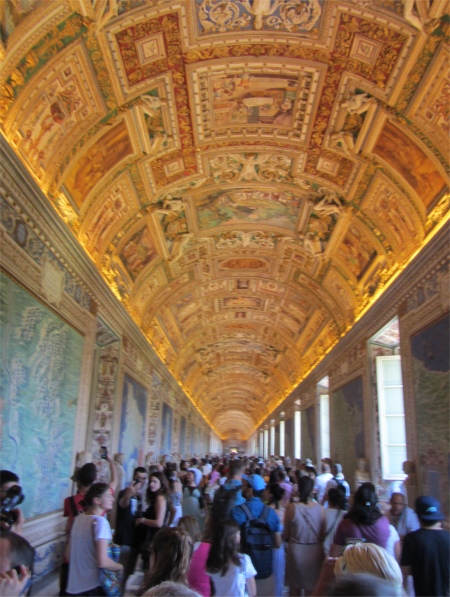
Galleria delle Carte Geografiche
|
Close to the Gregoriano Egiziano Museum lay the Pio Clementino Museum. The nucleus of the pontifical collections of classical sculpture dates back to the original collection of pope Julius II (1503-1513) which was housed in the Cortile delle Statue (today the Octagonal Court). During the second half of the 18th century the pontifical collections were enormously expanded both as a result of excavations being carried out in Rome and Lazio, and by donations from collectors and antiquaries. The influence of Enlightenment thinking resulted in the inauguration of a museum in the modern sense, open to the public and explicitly charged with the task of safeguarding antique works of art, and promoting the study and understanding of them. The Museum is called Pio Clementino after the two popes who oversaw its foundation, Clement XIV Ganganelli (1769-1774) and Pius VI Braschi (1775-1799). The museum fills several large exhibition halls which were obtained by adapting pre-existing rooms with new constructions both within and adjacent to the small Belvedere Palace of Innocent VIII (1484-92). Antique sculpture was brought here and ancient roman pieces have often had their missing parts completely restored. The neo-classical architecture was realised under the direction of Alessandro Dori, Michelangelo Simonetti, and Giuseppe Camporese and embellished by the work of a large number of painters and decorators. With the Treaty of Tolentino (1797) the Papal States were forced to give up the principal masterpieces in the Museum to Napoleon and they were transported to Paris. Much later, following the defeat of Napoleon and the Congress of Vienna (1815), and thanks to the diplomatic efforts of Antonio Canova, the greater part of the works were recovered.
We plunged into the torrent of tourists, the Vatican now brimming with humanity. The current whisked us through a long corridor, beginning with the Gallery of the Candelabra. This gallery takes its name from the massive marble candelabra which, together with the coloured marble columns, divide the exhibition area into six sections. Arranged under Pope Pius VI Braschi between 1785 and 1788, the gallery was completely renovated during the pontificate of Pope Leo XIII Pecci (1878-1903) and this is the decoration you see today.
Continuing through the Galleria dei Candelabri, the torrent dragged us into the Galleria degli Arazzi (Gallery of Tapestries). This is a deceptively simple room, yet it has treasures within. But the greatest miracle of these 27 tapestries is that they have survived at all. The tapestries were, for the most part, woven during the 1600s, though some are more recent. The impetus came from Pope Leo X as he considered the practice of popes, with an eye on posterity, making their own mark on the Vatican. These tapestries were intended for the Sistine Chapel. Pope Sixtus had commissioned wall frescoes from masters such as Botticelli and Perugino; his successor, Julius II, commissioned Michelangelo's fabled ceiling painting. The only place left was the lower walls, and Leo decided to cover these with a tapestry cycle.
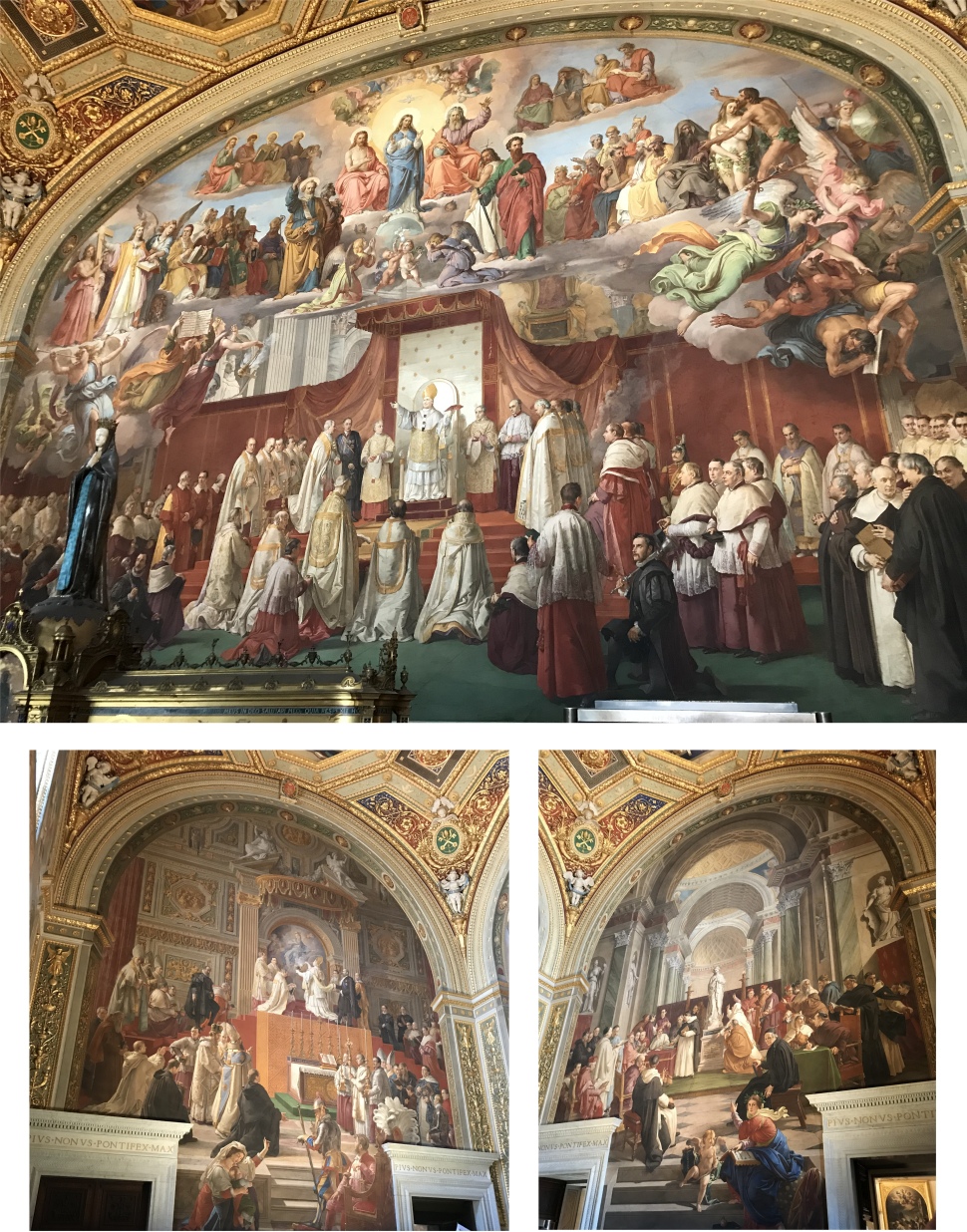
Sala dell'Immacolata
|
Leo X commissioned cartoons (drawings) from the painter Raphael in 1515, these to serve as patterns for the tapestries, and Raphael's pictures showed scenes from the lives of Saints Peter and Paul. Raphael was a brave choice, as tapestry design was traditionally the province of the Flemish artists (the actual weaving would be done in Brussels). Leo was to marry the aesthetics of the Italian Renaissance with the brilliance of the Flemish weavers.
The multitude of folk I was surrounded by now swept me straight on into the Galleria delle Carte Geografiche. I had no idea where Dan was in this turmoil. Predating a unified Italy by nearly 300 years, the gallery of maps at the Vatican shows the length and breadth of the peninsula circa 1580. Pope Gregory XIII commissioned the maps from his cosmographer, the multi-talented Italian priest Ignazio Danti. Gregory set his sights on the 120m long corridor on the third floor of the Belvedere Courtyard. The ambitious project to install 40 enormous and highly accurate maps began in 1580 and took just 18 months to complete.
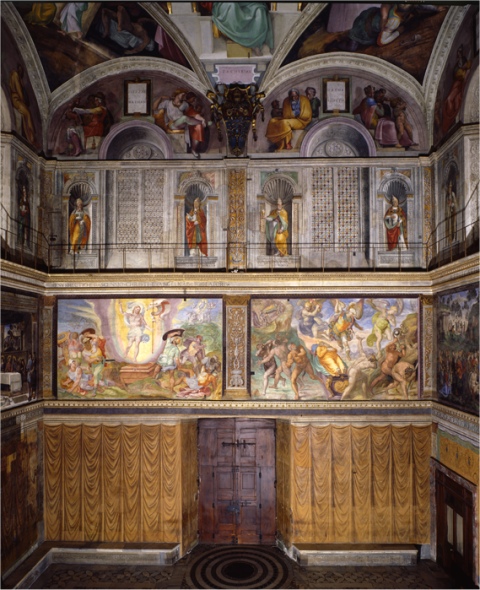
Sistine Chapel - Entrance Wall
|
I took a side turn to visit the Sala dell'Immacolata (Hall of the Immaculate). Following the proclamation of the dogma of the Immaculate Conception by Pius IX, which took place on 8 December 1854, the pontiff decided to celebrate the event with a cycle of frescoes. The large room adjacent to Raphael's Rooms is chosen and the assignment is assigned to Francesco Podesti (1800-1895), an Ancona painter rooted in the Roman artistic and academic panorama. The artist, together with his team of workers, worked at the company from 1856 to 1865, designing it and following its realization in all its parts: the doors and wooden doors of the windows and the exhibitions of inlaid marble, as well as the installation of Roman mosaic from ancient Ostia, bought specifically for this environment. The realization of the pictorial decoration starts from the vault, with allegorical scenes that allude to the virtues of the Virgin; continues on the north wall, with the continents paying homage to the Church on the throne; follows on the west wall, occupied by the Discussion of dogma, where Podesti demonstrates his ability as a portraitist in the characters gathered to discuss the sacred theme; culminating in the south wall, which houses the main scene, namely the Proclamation of the dogma, set in the Basilica of St. Peter; and ends in the east wall, with the Coronation of the Image of Mary, an event following the Proclamation and held in St. Peter's. Podesti, who was present, here inserts his own self-portrait.
I could have carried on to visit the Raphael Rooms, but that would have been fatal, I would have spent hours there, and Dan would never have forgiven me. I turned back and met up with him at the crossroads, and together we descended the stairs that led us down to the main attraction, the Sistine Chapel.
Wow, I knew this was meant to be stunning, but to see it there before me, the word "stunning" was completely transcended. After officials had rapidly ordered us into regimented areas, no doubt hoping the continuous flow of people would whizz through at the same pace as they did through the previous galleries, instructions were barked to us, "No talking! No photographs!" All Dan and I could do then was stand there shoulder to shoulder with hundreds of other souls, and open mouthed, slowly rotate to take in the marvels around and above us. The first Golden Rule in the Chapel is silence must be maintained - the actual din was unbelievable. The second Golden Rule is photography is prohibited - officials barged among the throngs shouting, "No photographs! No photographs!" - as effective as chocolate teapots. I should point out the photos that appear here are reproductions.

Sistine Chapel - North Wall
|
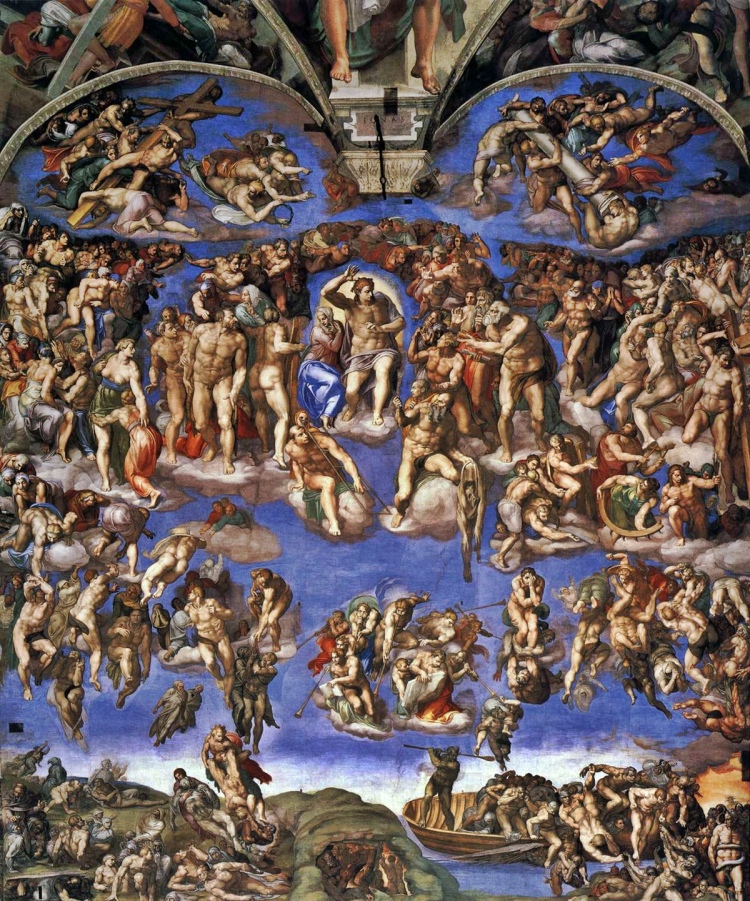
Sistine Chapel - The Last Judgement
|
The Sistine Chapel takes its name from Pope Sixtus IV della Rovere (pontiff from 1471 to 1484) who had the old Cappella Magna restored between 1477 and 1480. The 15th century decoration of the walls includes: the false drapes, the Stories of Moses (south and entrance walls) and of Christ (north and entrance walls) and the portraits of the Popes (north and south and entrance walls). It was executed by a team of painters made up initially of Pietro Perugino, Sandro Botticelli, Domenico Ghirlandaio and Cosimo Rosselli, assisted by their respective shops and by some closer assistants among whom Biagio di Antonio, Bartolomeo della Gatta and Luca Signorelli stand out. The decoration of the Sistine chapel, the ultimate treasure of The Vatican museums, was completed between 1534 and 1541 by Michelangelo, who painted the great altar fresco, The Last Judgement.
The Entrance Wall contained frescos of the two final episodes of the cycles of Moses and Christ: the Resurrection of Christ (Matthew 28: 1-8) and the Discussion over the body of Moses (Letter of Jude, 9).
Turning to the North Wall, the stories of Christ are distributed over six panels, each one presented by a title in the upper frieze. The events of the life of Christ start from his Baptism through to the Resurrection which ends on the Entrance Wall. Each panel of the stories has a corresponding false drape in the lower section with the enterprises of Sixtus IV. The series of Pontiffs ran along all the tops of the walls of the Chapel starting from that of the altar, in the centre of which could be seen Christ and the first pope Peter, as well as Linus and Cletus. The four figures were lost when Michelangelo, by order of Paul III, painted the Last Judgement on this wall in 1536. The Pontiffs are arranged in couples in niches beside the windows.
Another rotation and I was facing The Last Judgement which just oozed splendour and fear. The mighty composition, painted by Michelangelo between 1536 and 1541, is centred around the dominant figure of Christ, captured in the moment preceding that when the verdict of the Last Judgement is uttered (Matthew 25: 31-46). His calm imperious gesture seems to both command attention and placate the surrounding agitation. It starts a wide slow rotary movement in which all the figures are involved. Next to Christ is the Virgin, who turns her head in a gesture of resignation: in fact she can no longer intervene in the decision, but only await the result of the Judgement. The Saints and the Elect, arranged around Christ and the Virgin, also anxiously await the verdict. Some of them can be easily recognized: St Peter with the two keys, St Laurence with the gridiron, St Bartholomew with his own skin which is usually recognized as being a self-portrait of Michelangelo, St Catherine of Alexandria with the cogwheel and St Sebastian kneeling holding the arrows. In the centre of the lower section are the angels of the Apocalypse who are wakening the dead to the sound of long trumpets. On the left the risen recover their bodies as they ascend towards heaven (Resurrection of the flesh), on the right angels and devils fight over making the damned fall down to hell. Finally, at the bottom Charon with his oars, together with his devils, makes the damned get out of his boat to lead them before the infernal judge Minos, whose body is wrapped in the coils of the serpent. The reference in this part to the Inferno of Dante Alighieri's Divina Commedia is clear. As well as praise, the Last Judgement also caused violent reactions among the contemporaries. For example the Master of Ceremonies Biagio da Cesena said that "it was most dishonest in such an honoured place to have painted so many nude figures who so dishonestly show their shame and that it was not a work for a Chapel of the Pope but for stoves and taverns" (G. Vasari, Le Vite). The controversies, that continued for years, led in 1564 to the decision by the Congregation of the Council of Trent to have some of the figures of the Judgement that were considered "obscene" covered. The task of painting the covering drapery, the so-called "braghe" (pants) was given to Daniele da Volterra, since then known as the "braghettone". Daniele's "braghe" were only the first and in fact others were added in the following centuries.
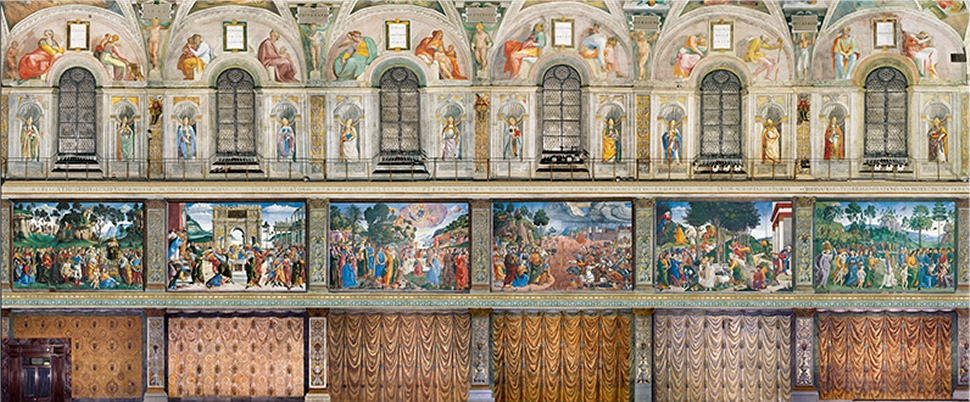
Sistine Chapel - South Wall
|
Turning once more to the South Wall, the stories of Moses are distributed over six panels, each one presented by a title in the upper frieze. The events start from the altar wall with the Old Testament cycle starting from the Journey of Moses in Egypt. The last fresco shows the Legacy and death of Moses (Deuteronomy 33: 34) when he is already within sight of the Promised Land. The cycle ends on the entrance wall with the Dispute over the body of Moses (Letter of Jude, 9). As with the North Wall and Entrance Wall, the series of Pontiffs ran along all the tops of the walls of the Chapel.
